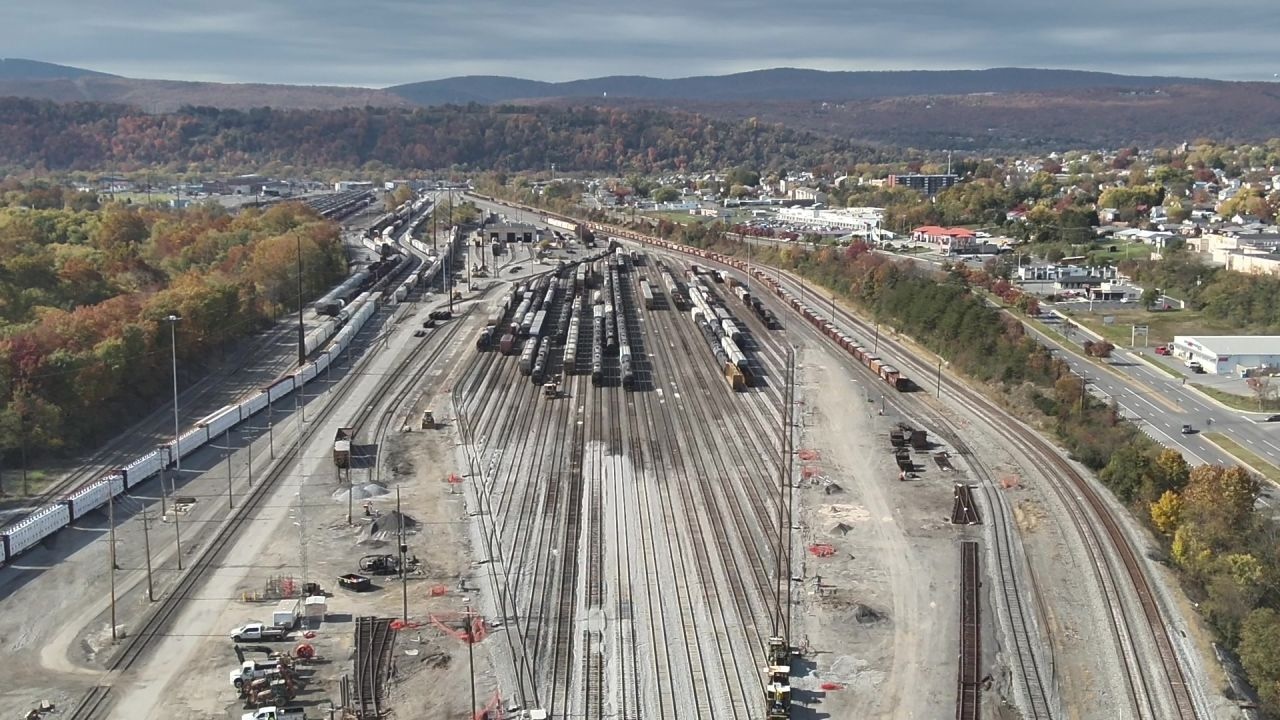
AMELIA ISLAND, Fla.— CSX is wrapping up work at Cumberland Yard in Maryland that will enable the former Baltimore & Ohio main line to handle merchandise traffic moving between the Mid-Atlantic and Midwest that’s currently routed the long way around via Selkirk, N.Y., on the former New York Central Water Level Route.
CSX has been running the carload freight via the hump yard at Selkirk because Cumberland has lacked the necessary switching capacity due to a combination of being converted to a flat-switching facility and the subsequent removal of yard tracks, says Chief Operating Officer Mike Cory, who joined the railroad in September 2023.
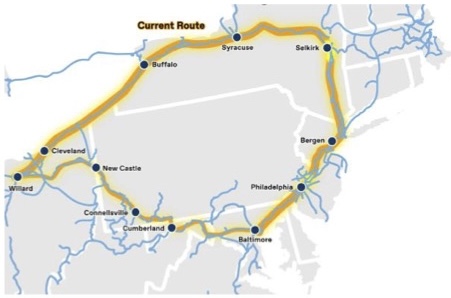
Shifting the freight to its natural routing via Cumberland will eliminate 29 million out-of-route miles per year, reduce car handlings by 59,000 annually, cut transit time, and produce $15 million in direct operational cost savings, Cory said at the railroad’s investor day last week.
The yard reconfiguration included demolishing the hump and hump tower. Three new switching leads and an additional 4,600-foot classification track were added. The switching leads, equipped with automated hydraulic switches, access 30 classification tracks.
Cumberland currently handles about 350 cars per day. Once the improvements are complete next month, the yard’s switching capacity will rise to more than 850 cars per day.
And then CSX will be able to shift a daily merchandise train pair to a Mid-Atlantic-Midwest routing via Cumberland. This will free up capacity at Selkirk, which will then be able to handle growth in paper, forest products, and waste traffic from former Pan Am Railways territory in New England.
Cumberland also will regain switching work that had been parceled out among smaller yards along the B&O, including Connellsville, Pa., and Brunswick, Md. Bringing the work back to Cumberland will save an average of 16 hours of transit time per car, Cory says, while reducing the number of local jobs operating at the outlying yards. Currently merchandise trains set out traffic that needs to be switched at the smaller yards, and the following day’s train then picks it up.
The return of a pair of merchandise trains to the former B&O also means CSX will be able to more efficiently take locomotives to and from the shop at Cumberland. Currently CSX often uses premium intermodal trains to deliver locomotives to the shop.

In May, CSX announced that it was making improvements at its former hump yards in Cumberland, Hamlet, N.C., and Willard, Ohio, which began operating as flat-switching facilities in 2017 as part of the railroad’s shift to a Precision Scheduled Railroading operating model.
None of the yards had the volume required to support classification via their humps and outdated retarder systems, which are expensive to maintain. Later on some tracks in the classification bowls in all three yards were crudely stub-ended, with piles of dirt and rocks serving as makeshift bumper posts. The changes limited the yards’ switching capacity, Cory says, while also making operations inefficient.
The railroad spent about $40 million on the yard improvements without increasing its capital budget for this year. CSX was able to free up funding for the work two ways, Cory says. First, giving track gangs longer work blocks has improved maintenance of way productivity across the system. Second, CSX has been able to postpone some capacity projects by making operational changes.
The biggest of the three yard projects, by far, is at Cumberland. “We’re completely remaking the yard,” Cory says.

Cumberland is one of the places where CSX continued to shove traffic over the hump while flat switching. “It’s something I’m not a big fan of,” Cory says, noting that blind shoves over and down a hump pose a derailment risk as well as a safety hazard for yard crews.
At Willard, CSX connected the pulldown to the departure yard. Previously yard crews had to spend 15 to 20 minutes performing run-around moves in order to get traffic from one side of the yard to the other. “We had to run around ourselves about three times,” Cory says.
The changes allowed CSX to boost Willard’s switching volume by a couple hundred cars.
Yard productivity has been hampered at Hamlet, where bowl tracks were severed at the hump, forcing switching to be done at the pulldown end of the yard. Plus, control of Hamlet’s switches had been transferred to the yardmaster in Charlotte, N.C., which sometimes resulted in switching delays at Hamlet.
Improvements at Hamlet include automating switches — returning control to local crews — and reconfiguring the lead, Cory says.
CSX is considering making similar efficiency improvements at yards in Indianapolis, Ind.; Louisville, Ky.; Atlanta; Montgomery, Ala.; Richmond, Va.; and Waycross, Ga.
At a time when it’s hard to hire and retain train crews, Cory says boosting yard productivity is essential so that CSX can get the most out of each yard crew.
Cory says he and Casey Albright, the railroad’s senior vice president of network operations and service design, have taken a collaborative approach with local operations leaders regarding yard improvements.
“It sounds simple, but when you bring people together and you include them and you allow them to say what they think – wow,” Cory said during an investor day presentation.
In Cumberland, this led to a revelation: A yard track, hidden behind a line of trees and used to store locomotives, could instead be freed up for live switching operations.
“Why were they storing them there?” CEO Joe Hinrichs asked Cory on the investor day stage.
“They were storing them there because they were afraid someone was going to rip the track up even more,” Cory says, adding that new rail had been installed on the yard track just three years ago.






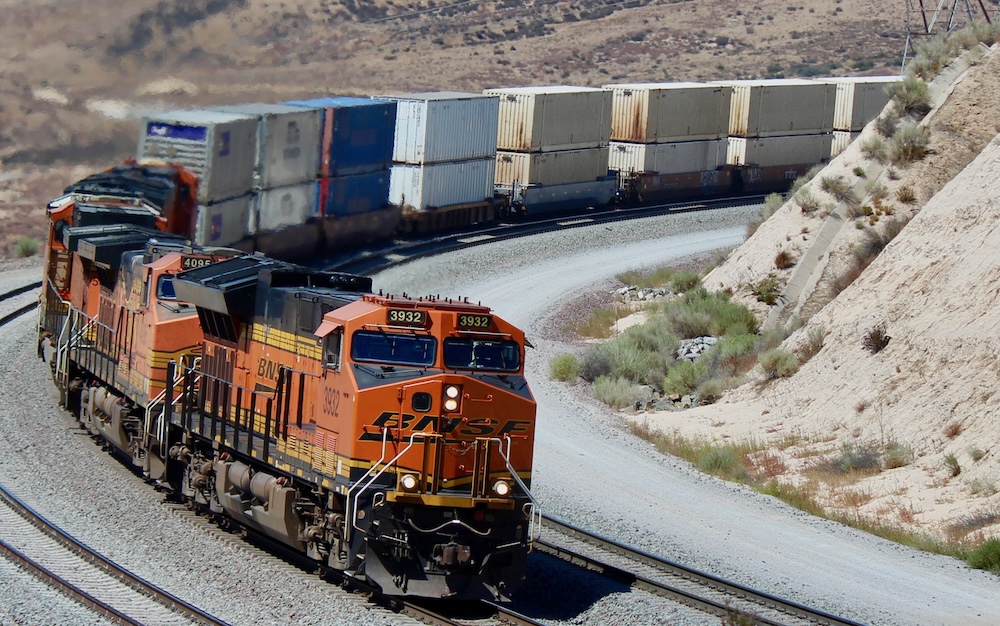
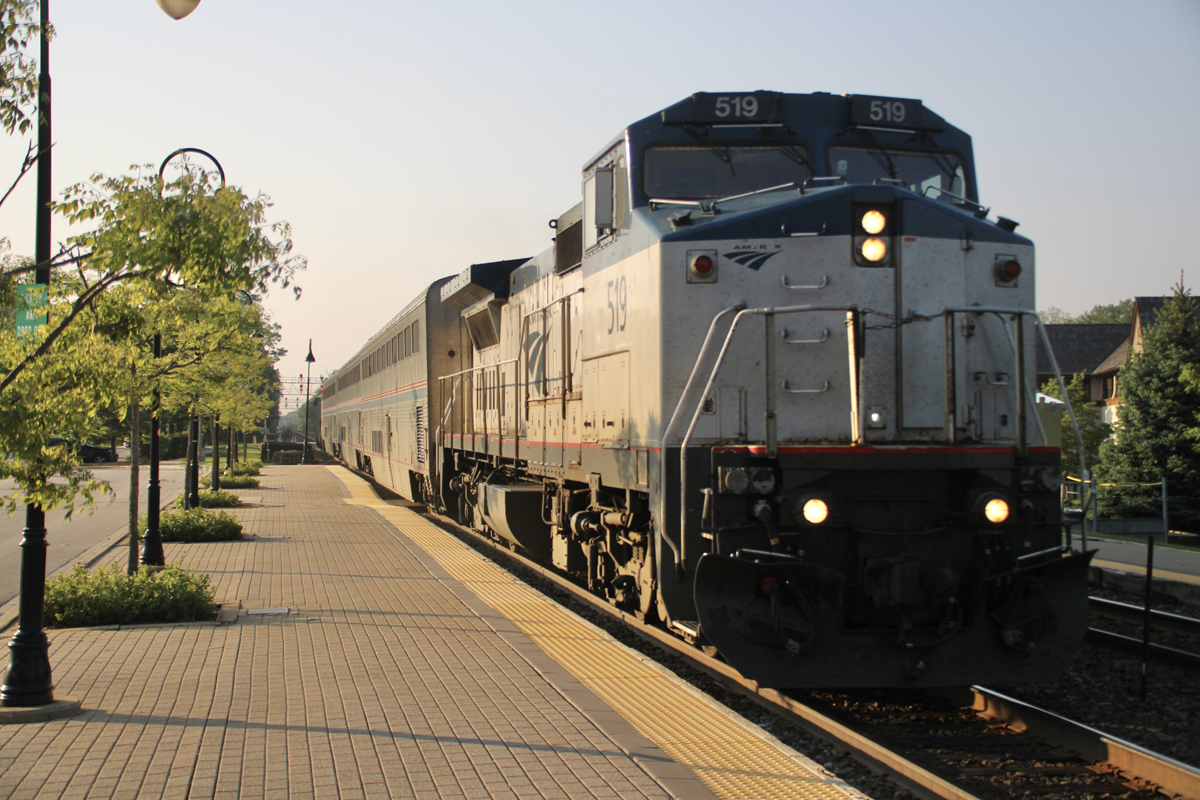
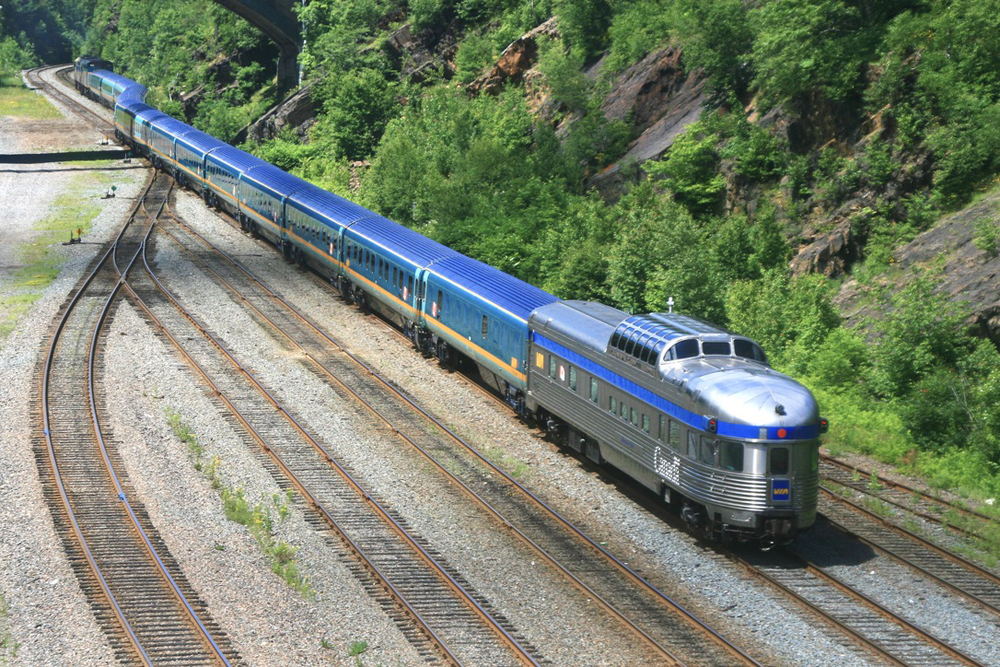
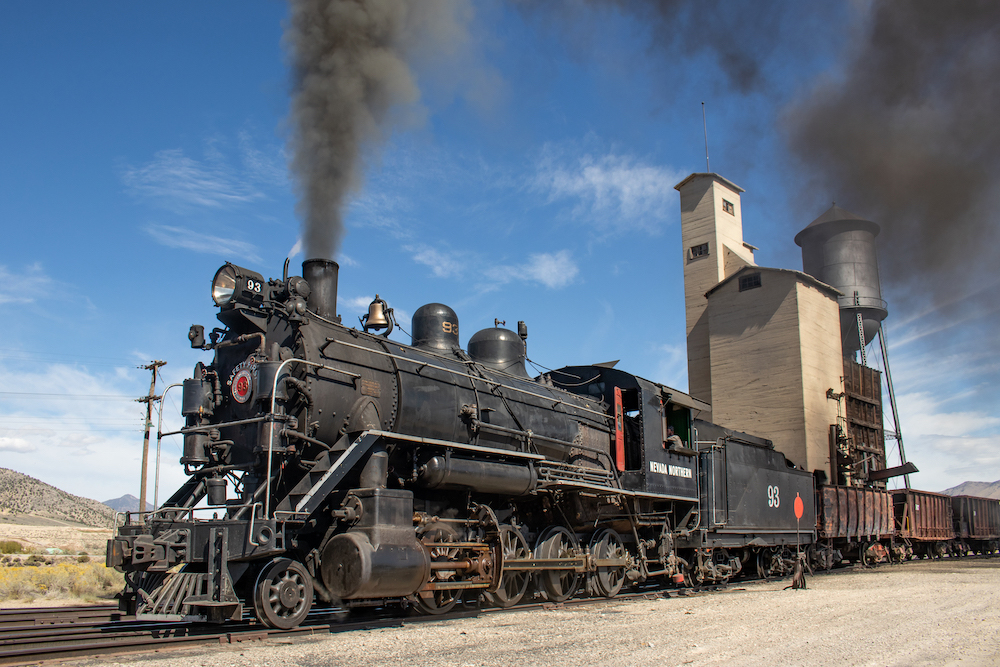




Would assume part of the problem with all the CSX yards mentioned is trying to handle all the super long freight trains on tracks not originally designed to handle trains that long.
What the article doesn’t say is what the yard capacity was before they ripped out the hump. I wonder if it was greater than it is now with the “improvements”. I’d call it a half-assed restoration ordered up by lame-brained idiots to partially fix the damage caused by the brain-dead idiots in the Harrison Regime.
Does anyone know what the origin-destination of these 2 re-routed manifests will be? Perhaps Oak Island to/from Willard? Currently it looks like CSX operates M369 Cumberland to Garrett; M370 Clearing Yd to Cumberland; M371 Philadelphia to Cumberland; and M372 Cumberland to Philadelphia. And there are Cumberland – Cincinnati and Cumberland – Indianapolis manifest pairs. And perhaps Selkirk to/from Philadelphia M403/M404 get eliminated? Thanks.
Bill mentions that the railroad could not support the other humps as there was not enough traffic to support them, and the cost was too high. Not to shoot or attack the messenger, I call complete B.S. from CSX of course. They should have never worked the PSR scam in the first place.
Stub ending yard tracks ? Clear PSR stupidity. And yes Jeff, abandoning and ripping up huge sections of the St. Louis to Clarksburg main was a huge mistake. While working as an engineer out of Queensgate in Cincinnati I would take Baltimore trains to Willard and shake my head at the inefficiency. Plus I worked sections of that line in Ohio that were still in good shape when it was all rebuilt before abandonment.
It makes you wonder if current CSX management regrets the late 1980s abandonment of the B&O mainline via Clarksburg-Parkersburg-Chillicothe-Cincinnati-Vincinnes-St.Louis. If that mainline was still in place, just consider how much time and money could be again saved using what was the most direct east-west route on the B&O.
Current Management didn’t have a say. They are just trying to manage what they got stuck with. Hunter Harrison was carrying a scythe around and swinging it, wacking off anything above a designated height (in this case, hump height!) taking the “savings” and claiming victory. Isn’t it interesting that it took someone from a large customer (Hinrichs @ Ford) to, as Trump would say, “Make CSX Great Again” by doing what Harrison didn’t think was necessary: Recreating the fluidity these yard needed by listening to the people actually running them. The story about the yard guys parking engines on a spare track, “in the trees,” so it wouldn’t get torn up is a classic of workaday railroaders using their instincts to preserve something they knew they needed to keep. That is why once UP ditched Lance Fritz and his PSR “run a muck” mentality, the railroad began to make gains by ditching all the in between mid-mid level management and listening to the people who do the job. They most often know what needs to be done and how things work. Who better to have input into their daily routine. Kudos to Hinrichs and Cory for listening to the “on the job trainers,” so to speak.
The abandonment of the B&O main was indeed a major mistake. Since the reconstruction of some of the Cumberland yard is a trend in the right direction to reverse the errors of the past, maybe there is a slim possibility that this former shortest route between the midwest and east coast could be reconstructed. A good case for a public private partnership to reconstruct the line to handle double stack trains reducing transit times from current routings. This former main use to handle trailer jets. In some locations running up to 70 MPH. Think of what that could mean today. But alas, railroads don’t work from the build it and they will come philosophy.
What Foote/Harrison rippeth out without talking to the employees, Cory/Hinrichs putteth back in with the employees. Undoing PSR in King James Version.
He that troubleth his own house shall inherit the wind: and the fool SHALL be servant to the wise of heart.
…. Proverbs 11:29 KJV
Good one John and Charles…